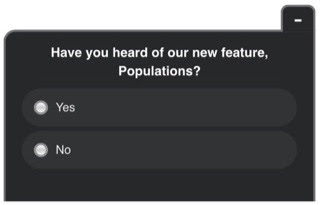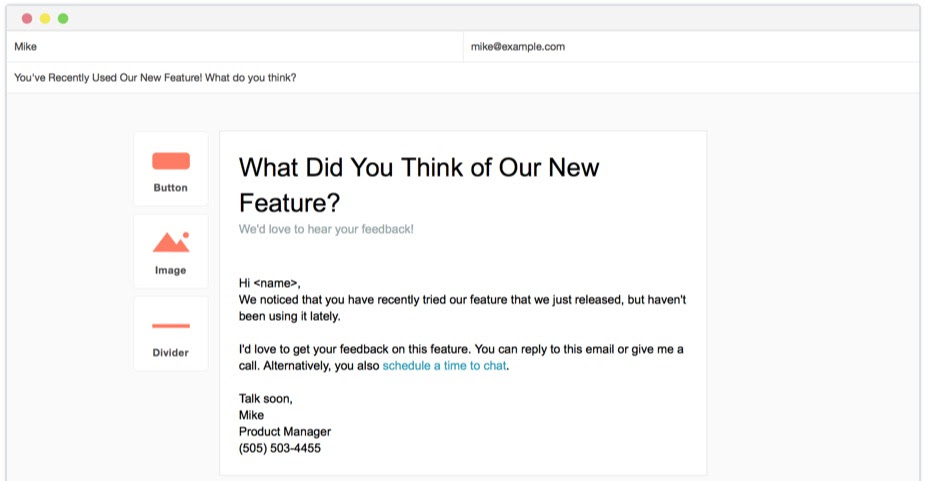When you launch a new feature, you can put adoption (or lack thereof) in four categories:
- Users that haven’t heard of the new feature
- Users that have heard of the new feature but haven’t used it
- Users that have heard of the new feature, used it once or a few times and stopped
- Users that have heard of the new feature, used it once and are continually using it
Each group of users need to be treated differently. And each group can be learned from to drive more product adoption and help direct future product releases.
Here’s how to do it in Kissmetrics.
Users That Haven’t Heard of The New Feature
You can find who fits into this group by using a simple yes/no survey from a tool like Qualaroo. You can place it on every page of your app and have it appear until the user provides a response:

For the people that select Yes, you can have a simple messaging saying Thank You. But for those that select No, you can prompt them to check out your new feature.

That’s one way to make sure newcomers are at least aware of your new feature and what it does.
But as the saying goes, you can bring a horse to water but you can’t make him drink it.
In this case, your user is the horse and the water is….ok, bad analogy. But you get the point. Awareness isn’t activation. Activation isn’t engagement.
So, that’s method #1. The other method involves using a little analytics from Kissmetrics. Just pull up a People Search and find the people that are current users, have received the email announcing the feature, but have not used it. While some of these people may have read the subject line, they aren’t too familiar with your new feature because they didn’t open the email and haven’t used the feature in the app.
Run that search, and you’ll get a list that looks something like this (just with different email addresses):

So it looks like there’s a few people that aren’t too familiar with this feature. For them, we’ll create an email message that we’ll send to them. We won’t have to leave Kissmetrics or export anything to do this. It’s all in the same solution.

We’ll send them an email about this new feature, and will create follow up emails for people that still haven’t used the feature. The goal here is to get users who haven’t heard of the feature to start using it and getting value out of it.
Users That Have Heard of Feature But Haven’t Used It
Now we have the group of users that are at least aware of the feature, but haven’t tried it yet. These users may have opened the email announcing the new feature, visited the feature page, asked a member of your support team a question about it, or click an in-app notification.
You can find any of these people with a simple People Search. Just plugin your conditions and date range, and run a search.
We’ll create a Campaign message for them. Since they’re already aware of the feature, this won’t need be a replica of the email announcement. Instead, we’ll try to entice them to try the feature using the power of social proof. We’ll use customer testimonials that we’ve collected.

This email will be sent to users who are aware of the feature, but have not used it yet. If they receive this email, open it, and still don’t use the feature, we can create another email with a different twist – maybe embed our product video into the email.
And we’ll do all the tracking in Kissmetrics. We’ll keep a watchful eye of the product engagement with Populations:

Now let’s go on to the next group of users.
Users That Have Heard of Feature, Used it Once or Twice, and Stopped
This group of users has heard of the feature, is aware of what it does, and has even tried it a few times before eventually not returning to it.
This group of users needs to be treated a bit differently than the previous two. We aren’t as interested as getting them to try the product as we are gathering feedback to see why they dropped off. The reasons will vary:
- I didn’t get value out of it
- I’ve been too busy to get to using it
- I’m about to cancel
To find this group of people, we’ll run a People Search for users that have used the feature no more than 3 times, have not used in the past 2 weeks, but have logged in in the past 2 weeks. This is to make sure we’re finding the active users that are logging in but are not using our new feature.
If there is a group of people in this search, we’ll create a Campaign and write our message. There are a couple ways we can go – we can either ask them for feedback on the feature or try to get them to use it again. Let’s first start with a feedback email.

We’ll send this email to our users that fit the criteria mentioned above. The main objective of this interaction should be to gather feedback to see which problems they run into (if any) and discover why they aren’t using the feature anymore, despite still signing in and using the product.
Users That Are Using the Feature Often (5+ times a week)
These can be known as our power users. They’ve not only heard of the feature, they’re actively using it. These users can be a source of feedback, and a few of them may even be willing to provide a testimonial that you can use in public. Some of them may even go a step further and write a positive review on a site like G2 Crowd or Capterra.
The search for these users is pretty straightforward. You’ll find users that have used the feature at least x amount of times in the last week. A good measure for most features is at least 5 – this way you’ll find people that have used the feature 5 or more times during the last 7 days.

We can also attempt to learn more from these power users and funnel those insights into future product development and marketing materials. For instance, if we find that the users that get the most use out of our tool are growth teams, but we’ve been targeting marketing teams, we’ll know we should consider modifying our marketing messaging to target growth hackers.
Unique Emails to Each User Group
Throughout this post, we’ve gone through four user groups and emails you can send to each group.
It’s important to keep in mind that these are separate emails going to different groups of users. We aren’t sending all these emails to the same customer group. For example, we won’t be sending the same email to power users as we do to users who have never heard of the feature. Each group gets its own email as they are treated differently and what we are looking to get out of them differs.
Conclusion
Building something people want is hard. At least, building something a lot of people want is hard.
Then, getting them to keep using it day after day, year after year is almost impossible without near-perfect, flawless product iteration.
Customer development can help. So can co-creation.
And good ol’ customer feedback through conversations and emails can also do the trick. Especially when it’s targeted towards a specific user group with differing product-adoption levels. Kissmetrics can help you identify these user groups, and you’ll even be able to send these behaviorally-targeted emails within Kissmetrics. Click the play button to learn more.
http://ift.tt/1SsY8tZ
Questions? Ask them in the comments.
About the Author: Zach Bulygo (Twitter) is the Blog Manager for Kissmetrics.

from The Kissmetrics Marketing Blog http://ift.tt/2tZugxQ


from WordPress http://ift.tt/2uX4gYG
Every week we feature a set of comics created exclusively for WDD.
